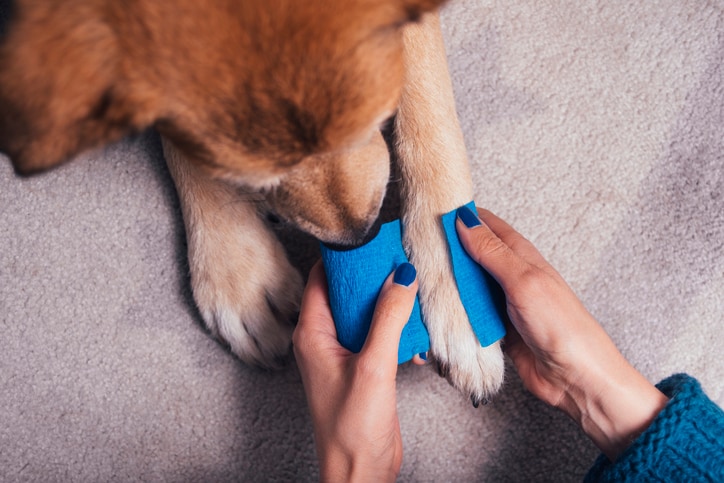In this article
Whether you own a pet or care for other people’s animals, it’s important to be prepared and know what to do if a pet emergency arises.
“Accidents and injuries happen. It’s part of life. But by knowing what to do (and what NOT to do) in a pet emergency when minutes count, pet professionals can offer a greater peace of mind to pet parents,” says Arden Moore, master certified pet CPR/first-aid instructor with Pet Tech and owner of Pet First Aid For You.
Plus, if you’re a professional dog walker, pet sitter, pet groomer or kennel owner, investing in the proper pet CPR and first-aid training and pet safety certifications will make you better at your job, look good on your resume and help you get new clients.
What’s included in pet CPR and first-aid training?
There are a wide variety of pet first aid and CPR certification classes offered for both pet care professionals and owners. Most classes provide a wealth of knowledge, but the main training usually covered includes:
- Understanding basic pet owner responsibilities.
- Administering medicine.
- Managing breathing and cardiac emergencies.
- Assessing vitals.
- Managing urgent care situation.
- Treating wounds.
- Treating electrical shock.
- Preparing for disasters.
You should also be familiar with common poisons — the ASPCA Poison Control Center is a great resource.
“A basic pet first-aid/CPR class is good, but professionals should also take extra time considering what types of mishaps are most likely in their field so they can prevent them.”
— Melanie Monteiro, pet first aid instructor and author of “The Safe Dog Handbook”
Decide what type of safety training and certification is right for you
The level of training and information you get will depend on you and the class you choose, but make sure you select a class that offers certification, so you can add it to your professional resume and skillset.
A basic class may not be all you need. “A basic pet first-aid/CPR class is good, but professionals should also take extra time considering what types of mishaps are most likely in their field so they can prevent them,” says Melanie Monteiro, dog safety expert, pet first aid instructor, and author of “The Safe Dog Handbook.”
For example, a dog walker is more likely to deal with an overheated dog, while a cage-free boarding place must have a plan to prevent collar accidents and a groomer should have deep knowledge of proper restraint techniques and wound care, etc.
“Owners should consider their pet’s age/personality and study up on what they need to address these safety concerns,” Monteiro adds.
Pets, not unlike children, can get themselves into dangerous situations. You should be prepared so you can tackle an issue should it arise or even learn how to avoid it in the first place.
Find a pet CPR and first-aid course near you
It’s possible to earn your pet CPR and first-aid certification online via e-training courses or in a one-on-one personal training session or group class. Many organizations offer these options nationwide.
For in-person pet first-aid and CPR certification options, a local veterinarian, animal hospital or shelter may either offer classes or will point you in the right direction to find one that will fit your needs. Also, the American Red Cross and Pet Tech can help you locate training classes in any area.
Though most of these classes focus on dogs and cats, some will teach CPR or first-aid for more exotic animals, like birds and lizards. Prepare to spend anywhere from two to eight hours to learn the necessary techniques and to receive certification. Some classes will even go as far to help learn “puppy-proofing” basics, proper restraint methods and herbal remedies or alternatives.
Build a pet first-aid kit
Any pet caregiver, even if you haven’t been certified in first-aid yet, should have a well-stocked first-aid kit. This kit will look a little different than the typical human kit but will prove essential for even minor injuries.
Here’s what to include in a pet first-aid kit, according to The American Society for the Prevention of Cruelty to Animals (ASPCA):
- Phone number, clinic name, address of your veterinarian as well as local veterinary emergency clinics.
- Absorbent gauze pads, adhesive tape, cotton balls or swabs and alcohol wipes.
- Fresh 3% hydrogen peroxide to induce vomiting (always check with veterinarian or animal poison control expert before giving to your pet).
- Styptic powder (an antiseptic clotting agent to stop bleeding).
- Over-the-counter antibiotic ointment.
- Saline eye solution.
- Artificial tear gel.
- Ice pack.
- Disposable gloves.
- Scissors with blunt end.
- Tweezers.
- Oral syringe or turkey baster.
- Liquid dishwashing detergent (for bathing).
- Towels.
- Small flashlight.
Other nice-to-have items include:
- Nylon leash.
- Self-adhering bandage (stretches and sticks to itself but not to fur — available at pet stores and through pet supply catalogs).
- Rectal thermometer and petroleum jelly (to lubricate thermometer).
- Current photos and descriptions of your pets to help others identify them in case you become separated.
Of course, this list can be modified based on your individual clients or pets, but these are good things to have on hand and know how to use.
Moore also encourages people to learn disaster preparedness in addition to first aid. “Mother Nature can become quite nasty quickly, and we need to prepared for caring for our pets should a hurricane, tornado, wildfire, flood or other natural disaster occur.”
Learning the necessary skills to diagnose or treat injuries will not only put you and your clients at ease but also will help you tackle any potential emergency with a level head and steady hand.



